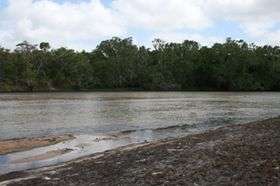Jardine River
| Jardine | |
| River | |
 Jardine River | |
| Name origin: Frank and Alexander Jardine[1] | |
| Country | Australia |
|---|---|
| State | Queensland |
| Region | Far North Queensland |
| Tributaries | |
| - left | McHenry River |
| Source | Great Dividing Range |
| - elevation | 100 m (328 ft) |
| Mouth | Gulf of Carpentaria, Coral Sea |
| - elevation | 0 m (0 ft) |
| - coordinates | 10°57′0″S 142°13′50″E / 10.95000°S 142.23056°ECoordinates: 10°57′0″S 142°13′50″E / 10.95000°S 142.23056°E |
| Length | 162 km (101 mi) |
| Basin | 3,282 km2 (1,267 sq mi) |
| National park | Jardine River National Park |
 Location of Jardine River mouth in Queensland | |
| [2] | |
The Jardine River is the largest[3] river of the Cape York Peninsula in Far North Queensland, Australia.
Course
The headwaters of the river rise southwest of Helby Hill in the Great Dividing Range and flow in a north westerly direction parallel to the McHenry River through the Jardine River National Park. The McHenry eventually discharges into the Jardine which continues north west combining with multiple other tributaries as it flows into the flatlands of the Jardine Swamps. It eventually discharges into Endeavour Strait near Van Spoult Head opposite Prince of Wales Island and into the northern waters of the Gulf of Carpentaria, part of the Coral Sea.[2]
Unlike other tropical rivers in Northern Australia, the Jardine flows all year round as the catchment receives sufficient rainfall throughout the year for it to do so.[4]
The river catchment occupies an area of 3,282 square kilometres (1,267 sq mi) of mostly uninhabited country, some 219 square kilometres (85 sq mi) of the catchment is made up of mostly freshwater wetlands.[5] The river has a mean annual discharge of 2,190 gigalitres (4.8×1011 imp gal; 5.8×1011 US gal).[6]
Fauna
A total of 46 species of fish are found in the river including; Sailfin Glassfish, Macleay's Glassfish, Barred Grunter, Marbled Eel, Hardyhead, Pennyfish, Mouth Almighty, Goby, Empire Gudgeon, Barramundi, Oxeye Herring, Northern Trout Gudgeon, Seven-spot Archerfish and Banded Rainbowfish.[7]
The Jardine River Painted turtle, previously thought to have been extinct after not being sighted in the river for 20 years, was discovered in the Jardine again in 2014. A team of Apudthama Cape York rangers and scientists from Origin Energy have trapped 24 of the turtles at two different locations using new trapping methods.[8]
History
The traditional owners of the area are the Unjadi[9] and Ankamuti[10] peoples who have lived in the area for thousands of years.
The river is named after the explorers and pioneers; Frank Jardine and Alexander Jardine.[1] The men came across the river as part of their 1864 expedition through Far North Queensland. In early 1865 the Jardines had just survived a pitched battle with the local Indigenous Australians and had some horses drown while crossing the Batavia River. the party was low on ammunition and food when they came across a stream they though was an escape but wasn't, they named it Deception River. The name was later changed by the government of George Bowen[11] to the Jardine River.[12]
See also
References
- 1 2 "Jardine River (entry 41953)". Queensland Place Names. Queensland Government. Retrieved 27 November 2015.
- 1 2 "Map of Jardine River, QLD". Bonzle Digital Atlas of Australia. Retrieved 9 June 2015.
- ↑ Moon, Viv; Moon, Ron (1991). Cape York. An Adventurer's Guide. Chelsea, Melbourne: Kakirra Adventure Publications. ISBN 0-9588264-0-4.
- ↑ "Jardine River National Park: Nature, culture and history". Department of National Parks, Recreation, Sport and Racing. 22 February 2012. Retrieved 10 February 2013.
- ↑ "Jardine River drainage sub-basin". Wetlandinfo. Queensland Government. Retrieved 9 June 2015.
- ↑ "Jardine river sub-basin within the Jardine - Pascoe Sandstones sub-bioregion". Wetlandinfo. Queensland Government. Retrieved 9 June 2015.
- ↑ "Jardine River catchment". Fish Atlas of North Australia. Retrieved 9 June 2015.
- ↑ "Queensland's 'fluoro' Jardine River turtles sighted for first time in 20 year". Brisbane Times. 29 August 2014. Retrieved 9 June 2015.
- ↑ "Unjadi". Australian Aboriginal tribal database. Ausanthrop. Retrieved 9 June 2015.
- ↑ "Ankamuti". Australian Aboriginal tribal database. Ausanthrop. Retrieved 9 June 2015.
- ↑ "Origin of Queensland names". The Brisbane Courier. Brisbane, Queensland: National Library of Australia. 8 February 1892. p. 3. Retrieved 9 June 2015.
- ↑ "Exploring Tropical Territory: The Jardine Expedition". Central Queensland History. Retrieved 9 June 2015.